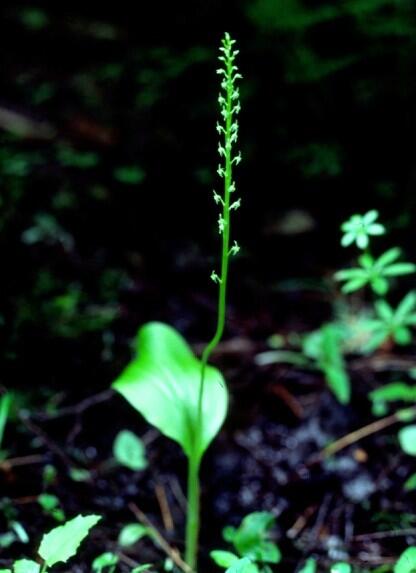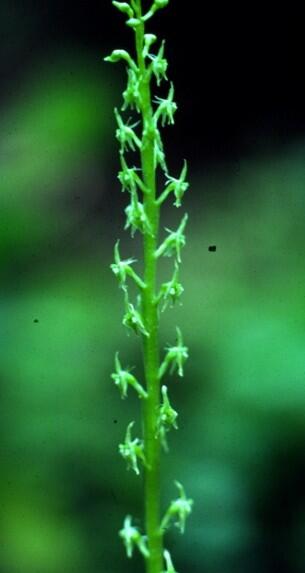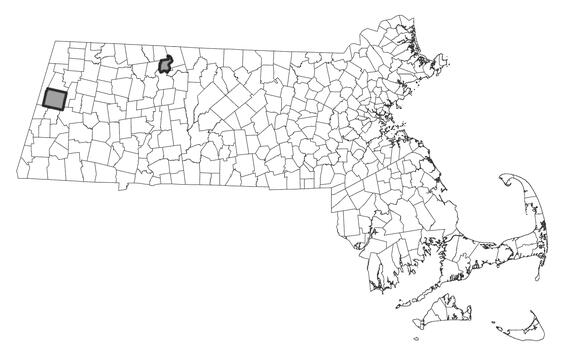- Scientific name: Malaxis monophyllos ssp. brachypoda
- Species of Greatest Conservation Need (MA State Wildlife Action Plan)
- Endangered (MA Endangered Species Act)
Description

White Adder’s-mouth (Malaxis monophyllos)
White adder’s-mouth is a diminutive, single-leaved orchid (family Orchidaceae) that inhabits rich shady bogs and fens. Its slender stem ranges from 3-30 cm (1.2-12 in) in height, and is loosely sheathed by a light green elliptical leaf, up to 9.5 cm (3.7 in) long. Up to fifty very small greenish-white flowers are held loosely along the upper part of the stem on tiny pedicels 2-4.5 mm (0.08-0.18 in), subtended by minute lance-shaped floral bracts 1.5-2 mm (0.06-0.08 in). The flower has a heart-shaped lip that tapers to an acuminate tip situated lowermost on the flower (resupinate). The petals are linear and reflexed, less than 3 mm (0.12 in) in length. The dorsal and lateral sepals are oval to lance-shaped, also less than 3 mm (0.12 in) long.
AIDS TO IDENTIFICATION:
- An orchid ≤ 30 cm (12 in) with a raceme of tiny greenish-white flowers
- Pedicels < 5 mm (0.2 in; as its epithet brachypoda, or “short-footed,” implies)
- Flower with heart-shaped lip
- One elliptical leaf (rarely two)
A shaded, calcareous wetland habitat
White adder’s-mouth can be confused with green adder’s-mouth (Malaxis unifolia, Threatened), a similar orchid also with a single-leaf. However, the flowers of green adder’s-mouth are greenish rather than greenish-white and are held on longer pedicels (5-10 mm; 0.2-0.4 in); further, its flower lip has two lobes with a central tooth. A second congener, Bayard’s adder’s-mouth (Malaxis bayardii, Endangered), is very similar to green adder’s-mouth, but is known mainly from dry, sandy habitats of the Massachusetts coastal plain, not from the wet rich sites occupied by white adder’s-mouth.

White Adder’s-mouth close up of flower stalk.
Life cycle and behavior

Population status
White adder’s-mouth is listed under the Massachusetts Endangered Species Act as endangered. All listed species are protected from killing, collecting, possessing, or sale and from activities that would destroy habitat and thus directly or indirectly cause mortality or disrupt critical behaviors. The Massachusetts Natural Heritage & Endangered Species Program has 10 records from 2 counties: Berkshire and Franklin. Five of these records have been observed within the last 25 years.

Distribution in Massachusetts. 1999-2024. Based on records in the Natural Heritage Database.
Distribution and abundance
This species is known from Alaska southeast across Canada to Newfoundland and south to New Jersey (historical), Pennsylvania, Indiana, Illinois, and Minnesota. It is disjunct in Colorado and California.
Habitat
In Massachusetts, white adder's Mouth occurs in small shaded calcareous wetlands in the western counties. It can be found in hillside seeps but is more often located in mossy depressions in hummocky, sphagnum moss-dominated sites shaded by eastern hemlock (Tsuga canadensis). Associated species include larch (Larix laricina), Sphagnum spp., sensitive fern (Onoclea sensibilis), royal fern (Osmunda regalis), and skunk cabbage (Arisaema triphyllum).
Healthy habitats are vital for supporting native wildlife and plants. Explore habitats and learn about conservation and restoration in Massachusetts.
Threats
Threats to white adder’s-mouth include invasion by exotic invasive plants, increases in light, and wetland disturbance or drying.
Conservation
Sites should be monitored for competition from invasive exotic plants and aggressive native plants; if necessary a vegetation management plan should be developed, in consultation with the MassWildlife’s Natural Heritage & Endangered Species Program. Known habitat locations should be protected from dramatic changes in light or moisture conditions. Rare plant locations that receive heavy recreational use should be carefully monitored for plant damage or soil disturbance; trails can sometimes be rerouted to reduce impact to the population. All active management of rare plant populations (including invasive species removal) is subject to review under the Massachusetts Endangered Species Act and should be planned in close consultation with the MassWildlife’s Natural Heritage & Endangered Species Program.
Contact
| Date published: | May 8, 2025 |
|---|